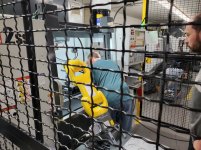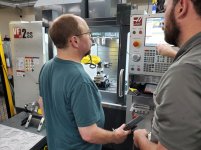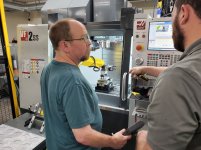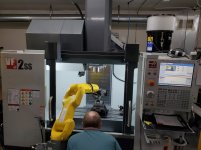Ok guys, sorry for lengthy delay between posts. You know me, I typically like to get these things posted and finished up pretty quickly, right?

With the 3rd quarter in full swing here, it seems everyone wants everything and they all want it now! Doing our best to stay ahead of the curve, but the road is slippery for sure!
Well, back to the install!
Finally, everything is set up and the install is complete!
Now, if we could just figure out how to make it work! lol

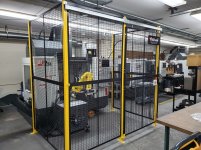
As mentioned and discussed previously, the enclosure does take up a fair amount of real estate, but seeing it now completed and up close from different angles, you get the true perspective and can see it is necessary in order to have some room inside to not only move about, but also for loading and unloading tables which we will add once we get it into production.
I am still baffled though as to the overall height, but ok, it is what it is.
The loading template they provide with the robot is basically useless, well actually, it is "completely" useless! The templates have 3" dia. cutouts in them. Fine if doing lathe work under 3" dia., but come on guys, WTF?, this is a mill. Give us something we can work with right out of the gate! And yes, regardless of the application for the robot, this is the template provided for either mill or lathe.
The gate has a locking interlock system which must be closed, locked and activated in order to run the machine in production mode. The remote touch screen control with jog handle is hanging on the right side of the machine so you can control the machine from outside the enclosure if necessary.

Here you see Andrew, familiarizing himself with the remote touch screen control and moving the robot around for the first time.

That look says it all! Andrew working with our new employee, Wall-E.
He is thrilled to the point of not being able to contain himself over this new direction the shop is heading in!

Here's an up close look at the remote touch screen control for controlling the robot.
I have to admit, it's a bit intimidating when you first see the control. Each axis (called a "Joint") on the robot is assigned a number and to be honest, I have no idea what that screen is currently showing other than the fact the highlighted "J3" is referring to "Joint 3" and that is the axis he is moving at that very moment the picture was taken.
Now that I've seen this pic it really pisses me off that Andrew spent 3 days working with the robot trying to get it to move in and out of the machine without issues, only to realize that when the tech came in to do the training, he noticed the robot is actually not oriented correctly on the base.
In that configuration shown, (angled towards the control and not the doors) it is set up for loading a lathe, not a mill. Poor guy. He struggled for 3 days with this and kept insisting something was not right as he worked with the robot.
By the way, the entire gripper you see here which is noted ay the (1 and 2) at the end of the arm, is an option. The robot only comes with a single gripper configuration. Pick up a piece, put it in the machine, machine the part, take it out, put it down, grab another piece, load it in the machine,etc.
With the dual gripper, it's take the finished piece out, indexes to the blank piece gripper, drops it off in the vise, comes out, drops off the finished part, and go get the next blank and wait for the machine to finish, etc.
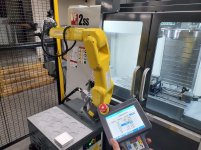
Since he is just in a "learning as he went along mode" so to speak, he was simply using the grippers already mounted on the robot rather than trying to change them out to "mill" grippers". Once again, how stupid is it they leave us with the robot set up for a lathe and even have round stock grippers mounted on the arm. Needless to say, at the very least he was becoming familiar with the control, the "joint" movements, and the set up screens on the machine control.

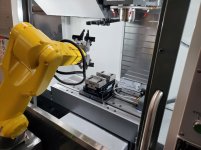
Here's Wall-E giving you the Peace sign!
Know why?
That's right folks, "I'll be back!"

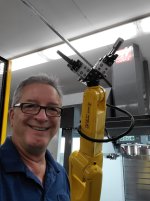
To be continued................













